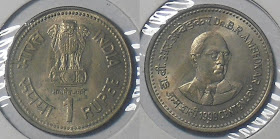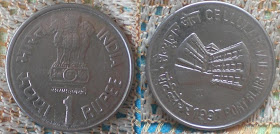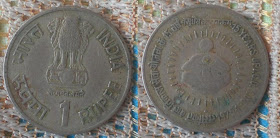1 rupee: BR Ambedkar centenary, 1990
 We can see BhimRao Ramji Ambedkar , also known as BabasahebAmbedkar on the obverse. Dr. B.R.Ambedkar was the architect of India's constitution. He was born into an untouchable family and spent his life fighting the prejudices and the discrimination base on which the Hindu society was divided into four classes, or theChaturvarna: the Brahmans, the Kshatriyas, the Vaishyas and theShudras. Facing numerous social and
We can see BhimRao Ramji Ambedkar , also known as BabasahebAmbedkar on the obverse. Dr. B.R.Ambedkar was the architect of India's constitution. He was born into an untouchable family and spent his life fighting the prejudices and the discrimination base on which the Hindu society was divided into four classes, or theChaturvarna: the Brahmans, the Kshatriyas, the Vaishyas and theShudras. Facing numerous social and
Ambedkar led an extensive fight against the practice and prejudices of untouchability. He became an active member of the Bombay legislative assembly in 1926 and in 1927 he started some movements against untouchability.He began with public movements and marches to open up and share public drinking water resources, also he began a struggle for the right to enter Hindu temples. He led a satyagraha in Mahad to fight for the right of the untouchable community to draw water from the main water tank of the town.
He is also credited with having sparked the Dalit Buddhist movement. Ambedkar has been honoured with the Bharat Ratna, India's highest civilian award.
One rupee, 1976

Weight: 10gm
Metal: Nickel
Obverse: Ashoka lion pedestal
Reverse: denomination and date
one rupee: cellular jail port blair-1997

This coin was released on the occasion of India's 50th anniversary of independence in 1997 by the then president Mr.K.R.Narayanan, and he also gave a a moving speech at the Jail to honour the former inmates of the cellular jail in Port Blair, Andaman and Nicobar Islands. The jail was established during India's struggle for independence with the view to send the freedom fighters to some deserted islands, so that their links to their families and communities would be severed and they would be forgotten into oblivion. The sentencing to the cellular jail was known as "saza-e-kalapani" and was the most dreaded punishment at that time if you were caught by the British government, probably even more dreaded than capital punishment. When the sepoy mutiny and the first all India war of independence was supressed, most of the freedom fighters were killed by hanging, bound to cannons and blown to bits or killed by guns and swords. Those who survived were sent to the Andaman Islands , where the only human inhabitants were the local tribes or Adivasis, like the Australian Aborigines. The island was a pure jungle.
Now, the history of the cellular jail is as fascinating as it is horrendous, as romantic as it is tragic. Unfortunately when the Japanese captured the Andaman Islands during the second world war, they burned down whatever was there, and all of the records that the British had kept were obliterated. This was a great loss to India's history as even though the British were exploiters, but they were also great record keepers. Even though extensive research has been done by the subsequent governments of India post independence, precious little has been found to establish the chronicles of the cellular jail.
The earliest revolutionaries to be sent to the Andaman islands had to face the worst treatment. In perennial rainy weather and marshy land, with snakes, scorpions etc around them and bound by heavy shackles, chains and fetters, they had to cut trees to clear paths in the jungle. They got flogged every time they slowed down and were not even given a full meal in a day. After the revolt of 1857, prisoners from national revolutionary movements, Alipore conspiracy case, Gadar party revolutionaries, Assembly bomb case, second Lahore conspiracy case, and from the Chittagong revolt of 1930 were also kept. The most famous inmate of the Jail was Veer Vinayak Damodar Savarkar(1883-1966)
The prisoners in the jail got highly inhuman treatment. According to Savarkar Freedom Fighters were made to do hard labour. They had to peel coconuts and take out oil from them. They were forced to go around like bullocks to take out oil from mustard seeds. Outside they were forced to clear the jungles and trees on hillside levelling marshy land. They were flogged on refusal. On top of this they did not even get a full meal every day.The food that was given was not fit for human consumption. There were worms when you opened the bread and wild grass was boiled and served in lieu of vegetables. Rain drinking water was full of insects and worms. The 13' X 6' cells were dark and damp and dingy thickly coated with moss. There were no toilets. There were no lights, no reading material. Prisoners were not allowed to meet with each other. The guards carried out physical torture and flogging. Their behaviour was insulting. Things had become unbearable.
So as a result, the only alternative before the freedom fighters was to resort to a hunger strike against these atrocities. On 12 May 1933 they started a fast undo death. Mahavir Singh, Mohan Kishore Namo Das and Mohit Moitra died during this hunger strike. Their bodies were quietly ferreted away and thrown out to sea. Punjab's jail inspector Barker was called to break the hunger strike. He issued orders to stop the issuing of drinking water. The freedom fighters were resolute. There was a huge outcry throughout India because of this hunger strike. After 46 days the British Raj had to bow and the demands of the freedom fighters had to be accepted. The hunger strike ended on 26 June 1933.
After the death of three colleagues the facilities won from jail authorities proved beneficial for the future. There was light in the cells. The prisoners started getting newspapers, books and periodicals. They were allowed to meet. The facility to read individually or on a collective basis was allowed. The opportunity to play sports and organise cultural events was given. The jail work was reduced to minimal. Above all there was respect for the freedom fighters from the prison officials and a marked improvement in their behaviour. A new environment was created as the freedom fighters met to discuss and read. A thirst for books and knowledge began. There were students, doctors, lawyers, peasants, and workers all together. They discussed politics, economics, history and philosophy.
There were classes in biology and physiology given by the doctors amongst them. Others gave classes in historical and dialectical materialism. Knowledge, experience and books were hungrily shared. A jail library was started. A veritable university of freedom fighters had begun where revolutionaries were learning about Marxist and socialist ideas and how to disseminate these amongst the people whose freedom they were fighting for. A Communist consolidation was formed of 39 prisoners on 26 April 1935. This number later swelled to 200. The freedom fighters started feeling that the atmosphere for a world war was gathering and that before the war starts we should get back to our country to be with our people and take active part in the upheaval that was imminent. A petition was sent to the Viceroy on 9 July 1937 by the freedom fighters that all political prisoners should be repatriated to the mainland and released An ultimatum was given that if these demands were not met a hunger strike would begin.
A second hunger strike began for the repatriation of freedom fighters on 25th July 1937.A country wide movement on the mainland in support of the demands of the Andaman freedom fighters began as other political prisoners in other jails on the mainland also started hunger strikes in support. There was a mass demonstration of working people, intellectuals and students. This upsurge clearly showed that their people on the mainland did not forget them. After four weeks telegrams from Bengal's chief minister, leaders of the nation Jawaharlal Nehru, Subhash Chandra Bose, Sharad Chandra Bose, Rabindra Nath Tagore etc poured in imploring the freedom fighters to end their hunger strike.On 28 August 1937, Gandhiji, poet Rabindra Nath Tagore and the Congress Working Committee sent a telegram…"the whole nation appeals to you to end the hunger strike… and assures you to take up your demands and to see them fulfilled…" After a lot of deliberation and discussion this historic 36-day hunger strike of 200 revolutionary freedom fighters ended. The process of repatriation started in September 1937.
There were classes in biology and physiology given by the doctors amongst them. Others gave classes in historical and dialectical materialism. Knowledge, experience and books were hungrily shared. A jail library was started. A veritable university of freedom fighters had begun where revolutionaries were learning about Marxist and socialist ideas and how to disseminate these amongst the people whose freedom they were fighting for. A Communist consolidation was formed of 39 prisoners on 26 April 1935. This number later swelled to 200. The freedom fighters started feeling that the atmosphere for a world war was gathering and that before the war starts we should get back to our country to be with our people and take active part in the upheaval that was imminent. A petition was sent to the Viceroy on 9 July 1937 by the freedom fighters that all political prisoners should be repatriated to the mainland and released An ultimatum was given that if these demands were not met a hunger strike would begin.
A second hunger strike began for the repatriation of freedom fighters on 25th July 1937.A country wide movement on the mainland in support of the demands of the Andaman freedom fighters began as other political prisoners in other jails on the mainland also started hunger strikes in support. There was a mass demonstration of working people, intellectuals and students. This upsurge clearly showed that their people on the mainland did not forget them. After four weeks telegrams from Bengal's chief minister, leaders of the nation Jawaharlal Nehru, Subhash Chandra Bose, Sharad Chandra Bose, Rabindra Nath Tagore etc poured in imploring the freedom fighters to end their hunger strike.On 28 August 1937, Gandhiji, poet Rabindra Nath Tagore and the Congress Working Committee sent a telegram…"the whole nation appeals to you to end the hunger strike… and assures you to take up your demands and to see them fulfilled…" After a lot of deliberation and discussion this historic 36-day hunger strike of 200 revolutionary freedom fighters ended. The process of repatriation started in September 1937.
Netaji Subhash Chandra Bose's Azad Hind Fauz first of all gave independence to Port Blair, Andaman. Netaji visited the Andaman Island and hoisted the tricolour flag on 30 December 1943. He had declared that the very first bastion to be relieved of the British yolk was Andamans, the Indian Bastille revolutionary freedom fighters were kept, very much like the Bastille in Paris during the French Revolution. The British reoccupied the Andaman and Nicobar Islands and abolished the Penal Settlement in 1945.
The Japanese destroyed two of the wings of the cellular jail during their brief occupation of the Andamans. Post independence the demolition of the jail was started(dont know or understand the logic behind it) and two more wings were destroyed. The former inmates of the jail intervened and the remaining three wings were spared, and the jail is now a national memorial in 1969, and the Gobind Vallabh Pant hospital was also started.
In 2004, parts of the jail were damamged by the Indian Ocean tsunami.
One rupee, 15 years of I.C.D.S.: 1975-1990

Weight: 6 gm
Metal: Copper-nickel
Diameter: 26mm
Subject: 15th anniversary of I.C.D.S.
Obverse: lion pedestal, denomination below
Reverse: Seated figure holding child, radiance surrounds.
I.C.D.S. stands for integrated child development services. The children are the most important aspect for Human Resource development as it is in the first 5-6 years of our lives that the foundations for cognitive, social, emotional and physical/motor development and also for life long learning.
The government acknowledged this fact and launched the integrated child development services(ICDS) in 1975 with a view for holistic development of the child.
The objectives of ICDS:
1)Lay the foundation for proper psychological development of the child
2)Improve nutritional & health status of children 0-6 years
3)Reduce incidence of mortality, morbidity, malnutrition and school drop-outs
4)Enhance the capability of the mother and family to look after the health, nutritional and development needs of the child
5)Achieve effective coordination of policy and implementation among various departments to promote child development
The services of ICDS include supplementary nutrition, non-formal pre school education, immunization, health check-up, referral services and nutrition and health education.
The pulse polio immunization campaign is the most well known initiative undertaken by ICDS.

No comments:
Post a Comment